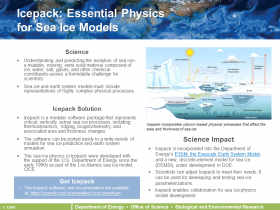Icepack: Essential Physics for Sea Ice Models
Icepack, a new modular software package, represents crucial sea ice processes including thermodynamics, ridging, biogeochemistry, and associated area and thickness changes. The software can be ported easily to a wide variety of models for sea ice prediction and earth system simulation.
Sea ice consists of a mixture of ice crystals, liquid brine, air, and other constituents of the ocean water from which the ice forms. A highly complex combination of thermal, radiative, kinematic and mechanical processes determines the composition, structure, and volume of sea ice. Heat tends to flow upward, from the warm ocean toward the colder atmosphere, impelling most thermodynamic sea-ice processes to operate in the vertical direction.
Because of its highly reflective surfaces, sea ice contributes critically to Earth’s energy budget, and its motion alters the distribution of salt within the oceans via melting and freezing. Understanding and predicting the evolution of sea ice–a mutable, moving, semi-solid material composed of ice, water, salt, gases, and other chemical constituents–poses a formidable challenge for both research scientists and prediction centers.
The Icepack software package consists of three independent parts: the column physics code, a driver that supports stand-alone testing of this code, and scripts that build and test the Icepack model. Thus, scientists can adjust Icepack to meet their needs: it can be used for developing and testing sea ice parameterizations, and its column physics can be implemented within diverse numerical models for both research and operational applications. Because it is independent of the mesh and dynamics that are specific to a given modeling center, Icepack further enables community collaboration for sea ice physics model development.


